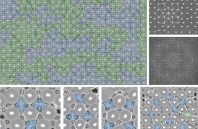Self-assembling materials called block copolymers, which are known to form a variety of predictable, regular patterns, can now be made into much more complex patterns that may open up new areas of materials design, a team of MIT researchers say.
The new findings appear in the journal Nature Communications, in a paper by postdoc Yi Ding, professors of materials science and engineering Alfredo Alexander-Katz and Caroline Ross, and three others.
“This is a discovery that was in some sense fortuitous,” says Alexander-Katz. “Everyone thought this was not possible,” he says, describing the team’s discovery of a phenomenon that allows the polymers to self-assemble in patterns that deviate from regular symmetrical arrays.
Self-assembling block copolymers are materials whose chain-like molecules, which are initially disordered, will spontaneously arrange themselves into periodic structures. Researchers had found that if there was a repeating pattern of lines or pillars created on a substrate, and then a thin film of the block copolymer was formed on that surface, the patterns from the substrate would be duplicated in the self-assembled material. But this method could only produce simple patterns such as grids of dots or lines.

 (585) 768-2513
(585) 768-2513

